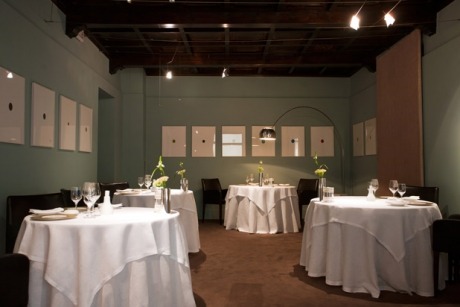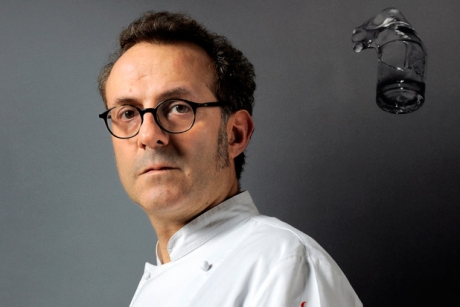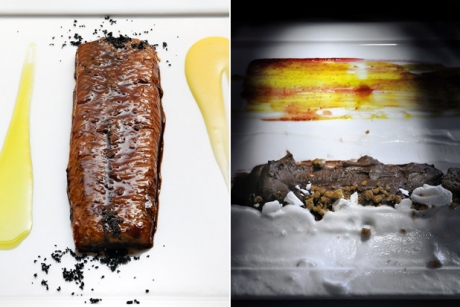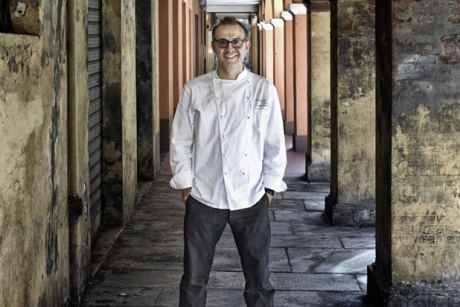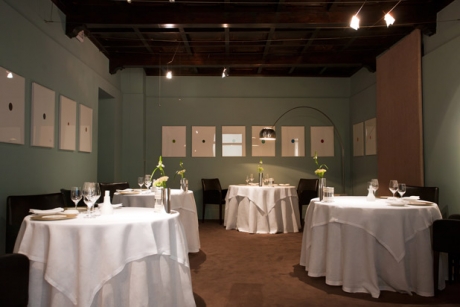2012 International Chef Of The Year: Massimo Bottura
Italy's newest Michelin-three-star chef, Massimo Bottura, cuts a smart, professorial figure. Descriptions and proclamations about his talent and import are just as flattering and impressive. Drawing on the wealth of his part of Italy's classic local products, but approaching his menus with a novelist's or historian's sense of narrative, Bottura is one of the most innovative chefs in the world today — and a good bet to start bringing back a little gastronomic glory to a food-crazy nation whose restaurants have lately been eclipsed by those of Spain and Scandinavia.
Read: The Daily Meal's Chefs of the Year 2012
Read: 2012 American Chef of the Year: José Andrés
Bottura's attractive contemporary-styled Osteria Francescana is located in Modena, in the gastronomically rich Emilia-Romagna region — famous as the home of Maserati, Ferrari, and Lamborghini, but also of aceto balsamico (the real balsamic vinegar), cotechino and zampone sausages, and such pasta as tortellini and tortelloni, so there's lots of tradition to draw from. Bottura deconstructs and reimagines tradition with such dishes as "memory of a mortadella sandwich," "five ages of Parmigiano-Reggiano in different textures and temperatures," "bollito misto... not boiled," and "Oops! Broken fruit pie." It's all delicious, and also lots of fun — ultimately, enough to top The Daily Meal's inaugural list of the 101 Best Restaurants in Europe.
For these reasons, we're pleased to announce that we've chosen Bottura as 2012's International Chef of the Year — joined by The Daily Meal's 2012 American Chef of the Year, José Andrés.
We reached out to both chefs to discover where they, and the state of food (in their opinion), may be heading. In this interview, chef Bottura talks about the challenges of having some of the world's best ingredients, the importance of narrative, and the secret behind a successful tasting menu. Check out the slideshow for photos of food from Osteria Francescana with commentary from Chef Bottura.
You've been hailed as one of the world's best chefs when it comes to balancing the demands of tradition and modernity — what's your philosophy behind this?
My kitchen can be defined as "tradition seen from 10 miles away." I revisit traditional recipes and ideas and make them contemporary. This is my speciality. I try very hard to respect tradition but also to respect ingredients, heroic farmers, butchers, and fishermen. Know your farmer, your butcher, your cheesemaker, and your fishmonger. When you have a relationship with the people who produce your food, it will always be better quality.
Rethinking a dish requires distance. Take a step back. Think about the core flavors of the recipe, why it ever came to be, and how it has survived for so many centuries. Then start taking away. You must think about texture, flavor, and form. Keep recipes simple, with distinct flavors that do not cover one another. What is better than tasting the real flavor of something, even something as simple as a potato? Sometimes, I have to ask if our traditions respect the ingredients and if they don't, then it is time to rework them. I call this "tradition in evolution."
Sometimes new ingredients are added. Sometimes the form is changed. Sometimes you have to try to reinvent the plate from scratch by throwing out the recipe. The most important thing is to apply a new way of thinking to an old idea without ever losing sight or respect for the ingredients and the traditions that bind you to the place you live. Here in Modena we have such amazing resources that we have only started to tap. I use ingredients from my terrain: Parmigiano-Reggiano cheese, prosciutto, handmade egg pasta, balsamic vinegar, and so on, but I think the most important ingredient to use in the kitchen is one's mind. Too often, people cook with their hands and not their brains. Actually, you need both.
Narrative is a big part of the dining experience at Osteria Francescana — the history and story behind each dish. Where does this love for narrative come from?
Actually, I think that the narrative dialogue that runs through my cuisine comes from growing up in a big noisy household with five brothers, aunts, uncles, and my grandmother at the table everyday. Sometimes there were 15 of us at a time. The conversation was always buoyant with the exaggerated tales that my brothers would tell, and my parents trying to keep us all in order. The conversation was as important as the food, and consequently I am no longer able to separate the two. Everything I eat, even the simplest pizza, has a narrative behind it, from the ingredients to the pizzaiola who makes and works the dough.[pullquote:right]
When I am working on a new recipe, the ideas are never abstract, but firmly rooted in a point of departure. It is never just about ingredients or an "amazing combination" of flavors, but about ideas that spin out from what I see every day in the world around me. Right now, I am working on a series of plates around the idea of "leftovers" and not throwing away even the tiniest scraps. Perhaps this is because Italy is facing a great economic crisis, or maybe I am getting old and just don't want to throw anything away, I don't know... but the recipes that come out of this reflection will have stories to tell, which I hope will last as long as the recipes themselves.
"An Eel Swimming Up the Po River" and "Trains Depart at Dawn."
Why do you think narrative is so important? And can people still enjoy food — yours in particular — without it?
Storytelling — food that tells stories, evokes memory, accounts for cultural differences, informs as well as nourishes, and lends to a greater sense of belonging — is not only a necessity, but a gift to future generations of chefs and diners. I want to tell a visual story to help the public understand the products I use and the territory I come from. The plates do not need explanations or lengthy stories to be understood or appreciated; however, a little history often enhances the diner's experience. When you go to a museum and look at the artwork you do not need a guide, but sometimes, when someone leads the way, you see the work in a new light.
Like many others who worked at elBulli, you've been faced with the problem of having learned from Ferran Adrià, often considered the most influential chef of our time. What can you take away from someone like this without copying what he does?
I learned a great deal from my experience with Ferran Adrià. What I brought home, however, was not a notebook full of recipes or techniques but an open mind about how to think in the kitchen. My first stage experience was with Alain Ducasse. That opened my mind to fine dining and the rigour of the Michelin kitchen. From there I worked on my technique and also on discovering who I am and where I live. Five years later, I arrived at elBulli. I already had a keen sense of where I was going and Ferran encouraged me to trust myself.
A good example of how I have worked through my experiences with other chefs can be seen in a dish called "Compression of Pasta and Beans," which I often call a compression of my gastronomic history, as it is served in a shot glass. The bottom layer is a crème royale, which represents my classical French training from Alain Ducasse. The top layer is "rosemary air," a direct nod to my experience with Ferran Adrià. In the middle there is the traditional part of the dish: bean purée and broken pieces of egg pasta. In this case, however, the pasta has been substituted for with thinly sliced Parmigiano-Reggiano crust. The chewy crusts not only recreates the pasta experience but aims for the heart: My grandmother Ancella, who prepared her broths with Parmigiano crust, let me chew them at the table. In Modena we all grew up eating Parmigiano crust, so this small gesture states where my heart is — forever in Emilia. I believe it is important to have an emotional element in every dish — that one thing that connects you to who you are and where you come from, even when you are aiming for the moon.
Is there a chef who challenges you? Who inspires you to greater things? Or at some point do you feel like you're competing against yourself?
I admire anyone who makes the hard choice to become a chef. There are no easy paths to success in this business. As Picasso often said, "Success is 10 percent talent, and 90 percent hard work." I have many chef friends around the world. The ones I admire the most are those who are trying to do what is in their hearts — not just as a business, but also as an art form. Living your dreams is the hardest thing you can do. All my respect goes out to those chefs who dare to make a difference in their community and country.
Dal Pescatore in the Mantovan countryside is a beautiful three-Michelin-star restaurant run by the Santini family. I appreciate their hard work, success, and the values they support. I would love to be the first ring of my own three-generation restaurant. I don't know if my daughter Alexa will join me in the kitchen, but I can dream about it. Italy was built on great families making sacrifices for each other. Today, this is something that risks being lost forever. Nadia Santini is a perfect role model, as she has been working with local producers and traditions for the past 30 years. Her cuisine is never outdated, but always fresh and full of emotional impact.
What do you think the secret is behind a successful tasting menu?
We are never satisfied. We try to keep on our toes and push each other harder and harder to give our guests a unique and emotional experience from the kitchen and from the waitstaff.
We offer our guests three tasting menus in addition to the à la carte menu. There is the Traditional Menu, which pays tribute to Emilia-Romagna in ingredients, traditions, and terroir. The Classics Menu is a best of Francescana, which year after year is updated and revised, based on the best plates from that year and the classics that guests are always asking for. Then, there is the Sensations Menu, which is always changing and evolving based on seasonal offerings. Some wonderful examples are "Autumn Leaves," which captures early winter flavors in the form of frost-covered leaves. You literally eat sugar-frosted aromatic leaves with mushrooms, pumpkin, chestnut, and hazelnuts. This is like bringing the outside inside. Or "Camouflage: A Hare in the Woods," which is a return to the classic French civet with a modernist twist based on a wonderful Gertrude Stein account of Picasso in 1914.
With these three very distinct menus, we are able to tailor to the diverse experiences and desires of our guests. Two separate tables can have completely different experiences at Osteria Francescana. We think this is very special. No two meals are ever the same because each guest is unique. For this reason we keep our tables to 12 to guarantee individual service and attention to everyone.
We expect you'll be involved with many new projects and exciting things for years to come, but if you were to reflect now on what you wish your legacy would be as a chef, what would you say that is?
Legacy is a big word. Becoming a chef was not my first choice. It happened by chance. But I am glad that it did mostly because I am able to speak to so many young chefs around the world and encourage them to follow their dreams. I love entering the kitchen every morning and seeing the crew getting prep started. When the energy and the people are right, there is a real sense of "nothing is impossible." The beauty of my job is that it is tangible and intangible at the same time. Walking the fine line between these two worlds, I see so many connections to the arts, music, and literature. And I feel very honored to have a voice in this discussion.
Recently, I have been talking a lot about Italy. And my new tasting menu is called "Come to Italy with Me." I hope to be part of a revived Italy, a proud Italy, and an economically secure and creatively supported Italy. There is still so much to be discovered here — tasted, touched, and seen. I will be traveling this March to Washington, New York, and Los Angeles representing Italy with this menu for a year of Italian culture in America. This project is the first step in realigning our culinary values with our cultural values. My legacy as a chef is as an ambassador for the Italian kitchen making sure that there is plenty of space to grow by seeing our past from a critical point of view, not a nostalgic one. May "Tradition in Evolution" become a catchphrase among the next generation of Italian chefs... footballers, designers, artists, writers, architects, and engineers. Why not?
And what else would you like it to be?
In my future I see more future. And my best recipe is the one I have yet to make.
What's your assessment of the state of food and dining in Italy? Is food exciting in Italy right now? If so, which one Italian chef should the world look out for?
I am an Italian chef, born and raised in Emilia-Romagna. At 50, I am still discovering new Italian flavors. I am asking myself, "What are authentic Italian flavors?" A great part of my investigation is about throwing away my own assumptions about tradition, territory, and ingredients — clean slate. I am tasting, traveling, and discovering within my own country and outside as well. I am interested in what other people think is Italian food and adding that to my reflection. Italian food is internationally appraised and yet it seems still to be stuck in someone's grandmother's kitchen. It is as if Italian food is not allowed to evolve. Everyone talks about authenticity, but I am not sure that that is really what they are aiming for. It almost seems like copying off someone's test and not thinking things through properly.
Italy's greatest resource is its artisans. We must support them and reflect light on them in order to guarantee that the next generation of artisans will be there for our children and grandchildren. It is very important that young chefs do not lose themselves in their own dreams of grandeur, but keep building for the future of Italy. The more we focus on territory, on the amazing resources we have been given by our ancestors, the more we are able to create recipes with lasting value. Ethics and aesthetics go hand in hand. Think about the power of Slow Food and how it has changed a generation of chefs. This is the trend for the next decade, and maybe forever. Someday instead of chef superstars, there will be farmer superstars. That will be a great day indeed.
What's good about Italian cuisine right now is the feeling amongst contemporary chefs. We are all on the same page trying very hard to move the Italian kitchen forward. This means collaboration — organizing events, being present at conferences, traveling, and communicating. Events such as Identità Golose in Milan, or Festa Vico in Vico Equense, Naples, are opportunities to share ideas and gather momentum. Another great thing about the Italian kitchen right now are the exceptional artisans that are providing us with incredible products — from the almonds in Noto and the Zibbibo vinegar in Pantelleria, to Pienolo tomatoes from the hills of Vesuvio and Alpeggio ricotta. Every corner of Italy today has a gem waiting to be discovered and to be put to work in our kitchens. Thanks to them, we are able to express ourselves through these details.
Right now in Osteria Francescana, we are re-evaluating Italian classics and the extraordinary ingredients they are made of. These plates fall under the "Come to Italy with Me" theme, which is actually an invitation to explore Italy with new eyes... and an open mind. Not to look for what you know but to seek out undiscovered flavors. Risotto "cacio e pepe" is a new recipe that takes a Roman staple and turns it into an Emilian re-visitation using Parmigiano-Reggiano instead of Pecorino Romano and rice to remember the mondine from Nonantola [the famous women rice-harvesters from an area near Modena] instead of spaghetti from the south. It may sound simplistic or banal, but the early reactions from our guests are surprising as we are touching upon the "familiar Italian comfort food" but not stopping there.
There was a knock on my office door this past June. There stood Italy's best chefs — and my dearest friends — gathered together for a surprise lunch at Osteria Francescana. They came to show their solidarity during a difficult time due to the May earthquakes suffered here in Emilia. This group of Italian chefs represent the future of Italian cuisine. They are: Massimo Alajmo, Davide Scabin, Ciccio Sultano, Norbert Niederkofler, Mauro Uliassi, Moreno Cedroni, Carlo Cracco, Chicco Cerea, Antonino Cannavacciuolo, Andrea Berton, Giancarlo Perbellini, Gennaro Esposito, Niko Romito, Heinz Beck, and the youngest of all, Giovanni Santini. Stop at any of their restaurants, and for sure, you will have an incredible experience. The best Italy has to offer.
Where are the most interesting things in food happening?
They are happening all over. First, they are happening in people's kitchens, and that is amazing. So many people are returning to the stove. Interesting things are happening in gardens and farms, on rooftops, and in unlikely terrains across the globe. Finally, farmers are getting some credit where credit is due. This is very important.
After nearly 20 years, I returned to Hotel de Paris to celebrate monsieur Ducasse's 25th anniversary there and I found it just as stimulating as when I left. I've just returned from South Africa where I tasted some incredible produce, fruit, and wine. I am on my way to Chile in January, and am very curious to discover the culture and the food there. Eataly is opening another gourmet Italian grocery in Chicago after the most recent opening in Rome, and before that New York. Finally a new formula for civilized grocery shopping.
Who would your choice for chef of the year be?
There are a few chefs who are not only cooking in the kitchen, but heating things up outside the kitchen as well. This is admirable because they are using the kitchen as a vehicle for reform. Gastón Acurio in Peru and Ben Shewry in Australia are blending ethics and aesthetics into their diverse landscapes and cultures. And then there is the next generation of bright young Italian chefs popping up in unexpected places with Michelin stars on their horizons.
Read: The Daily Meal's Chefs of the Year 2012
Read: 2012 American Chef of the Year: José Andrés
Arthur Bovino is The Daily Meal's executive editor. Follow Arthur on Twitter.
